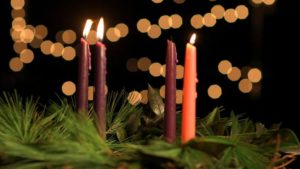
The Advent wreath was originally a German and Scandinavian home devotional practice used to mark the four weeks of Advent. Although many symbols have been attributed to it since that time, it was originally intended as a way to mark the Advent season and the weeks until Christmas.
Families would light a candle for each past week and the current week at their dinner or evening time of prayer. The configuration of candles, whether in a line or a circle, did not matter. Neither did the color of the candles (all colors are used in homes in Europe). What mattered was the marking of time and the increase of light each week in the face of increasing darkness as the winter solstice approached.
As Advent wreaths began to be used by congregations on Sundays in some places in Europe and America beginning in the late 19th century, adaptations were needed for the larger worship spaces. Candles needed to be larger and more specialized than the “daily candles” handmade or purchased for home use. They also needed to be more uniform in color to fit with other decor in the sanctuary. Purple (and more recently blue) has become the basic color of the candles to coordinate with color of the paraments used during this season.
As Advent wreaths changed from practical private use to the more symbolic context of public worship, it became important for the candles to have meaning rather than simply mark time and add light. Ceremonies were developed around the lighting of the candles each week.
In time there was an effort, largely spurred by church supply houses that sold the special candles and wreaths, to provide a particular meaning to each candle. The themes of Hope, Love, Joy, and Peace became popular, based on scriptures from the one-year lectionaries used at that time. However, the historic theme of Advent is more broad and deep than any one-word theme can capture.
So what are we to say, then, about the meaning of the Advent wreath today? We can still draw meaning from its original home use: to mark time while increasing light. Advent, the first season of the Christian year, is all about time. We await the day described in Revelation 21:23 when, “The city doesn’t need the sun or the moon to shine on it, because God’s glory is its light, and its lamp is the Lamb.” At Christmas we celebrate that in Christ, “The true light that shines on all people was coming into the world” (John 1:9).
Have questions? Ask The UMC or find a pastor near you to talk with. And check out other recent Q&As.
This content was produced by Ask The UMC, a ministry of United Methodist Communications.